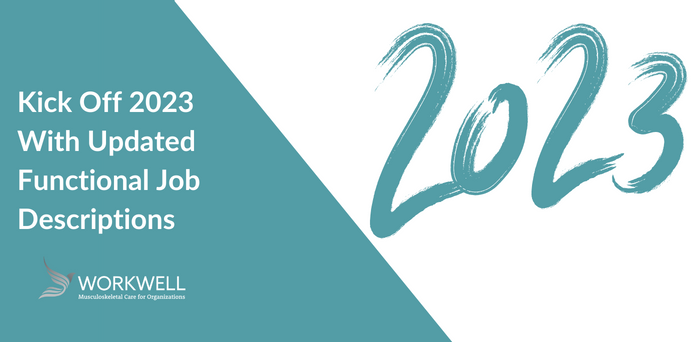Prevent It


5 Reasons Why You Need to Update Functional Job Descriptions for 2023
When was the last time you updated your functional job descriptions (FJDs)? Functional job descriptions protect both the employer and the employees. FJDs protect workers' safety, clearly outlining the job's physical requirements. On the business side, FJDs protect the company from numerous liabilities. Updated FJDs are like "preventive medicine" to protect both employees and organizations.
Functional Job Descriptions (FJD) are a crucial element of a strong safety culture and serve as the foundation for good occupational health. FJDs document a job's critical physical demands, including required tasks, specific movements, forces, postures, and load weight a worker will undertake when performing their duties.
Let's explore the top five reasons your company may be at risk:
- OSHA Audits - Random and unexpected OSHA audits can happen at any time. The FJDs must be current, or you will be deemed non‐compliant and subject to fines. You need to eliminate your company's exposure. Are you ready?
- Litigation Liability - Suppose you're in court defending your company in a personal injury case where an employee blames your company for making them work outside their job scope. In that case, you will be unable to prove your case without the benefit of an updated FJD. This document demonstrates the employee's established physical requirements and job duties.
- Invalidated Pre‐Work Screenings and Post‐Injury Tests -Many key employment decisions hinge upon the updated FJD. If your FJD is out of date, this has a two‐fold repercussion. The first is that the pre‐work screening results won't be valid for your new hires, as they weren't pre‐screened for certain physical aspects of the job. In a post‐injury situation, doctors and therapists will also use the FJD to test the employee and determine if they are ready to return to work.
- Minimize Workers' Compensation Risks - The FJD protects a company from inadvertently setting up a new hire for failure in its role. The physical requirements clearly stated in an FJD drive the skills and physical capabilities you seek when hiring new employees. Minus the refreshed FJD, the profile of the job's physical needs may be a little off, or worse, incomplete, and result in a poor hiring decision, resulting in a greater likelihood of a musculoskeletal injury or soft tissue injury.
- EEOC and ADA Compliance - An updated FJD protects your company from the exposure of non-compliance if an employee with a disability files a discrimination grievance. For example, suppose an employee is colorblind, and the ability to identify colors is a key part of their job sorting widgets on an assembly line.
Select a topic
- View all topics
- WorkWell
- Safety Culture
- Onsite PT Clinics
- Ergonomics
- Injury/Illness Prevention
- Employee Wellness
- MSK
- Industry News
- POET
- Safety
- Managed Services
- Manufacturing
- Functional Job Descriptions
- Onsite PT
- FJD
- Post Offer Employment Training
- Provider Network
- Blog
- Events
- Featured
- OSHA
- Work Readiness
- Company News
- Job Coaching
- MSK Strategy
- Musculoskeletal
- PT Solutions Employee
- Presenteeism
- Push/Pull
- Recruitment
- Training
- Trust
- Worksite Rounds
Subscribe to Our Blog
Practical tips focused on workplace injury prevention.
Featured Posts
postsTags [BlogPost 178613021575 Shift to Prevention and End the Game of Whack-a-Mole, BlogPost 125116526205 Why now is the time for a Managed Onsite MSK Clinic]
.png)

